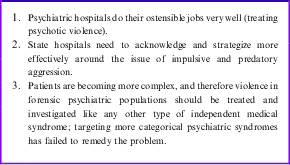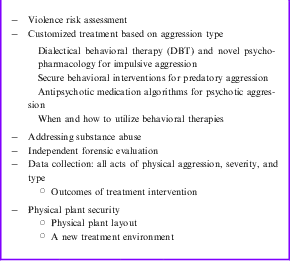Introduction
Are psychiatric inpatient settings more violent, and if so, is it related to increasing numbers of forensic patients? The question is frequently raised in discussions regarding state hospitals, and there has been significant media attention on the issue.Reference Finz and King 1 – Reference Jaffe 14 Forensic psychiatric populations appear to be growing, both in terms of mentally ill inmates in correctional settings, as well as criminally committed patients in state hospital settings.Reference Anderson and West 15 – Reference Torrey, Kennard, Eslinger, Lamb and Pavle 20 In many cases, physical aggression attributed to an underlying mental disorder is the primary reason for state hospital admission. Although anecdotal reports suggest that violence is increasing in certain inpatient psychiatric settings, varying and imprecise definitions of the term “violence,” combined with limited longitudinal research, make this apparent trend of increasing violence difficult to confirm scientifically.Reference Binder and McNiel 21 – 25 However, there is enough evidence to support the exploration of new conceptual models for case formulation, therapies, and therapeutic environments.
Utilization of a model where psychiatric violence is approached dimensionally, as a primary medical syndrome rather than the product of one, may allow for more effective interventions; focus on the presenting problem will allow clinicians to better understand, assess, predict, and treat physical aggression in a systematic and evidenced-based manner. In this model, the collection of violent behaviors running together may stem from a variety of etiologies and diagnoses; this dimensional rather than categorical approach will provide better focus on the true presenting clinical issue, rather than the rote treatment of a categorical diagnosis.
Beyond formulations and interventions, there is a pressing need to address violent milieus. Mental health facilities have an obligation to provide appropriate physical plant security to prevent the serious injury and death of staff members and other patients, while simultaneously creating a treatment environment that maintains therapeutic value.
Is There a New Type of Patient? Mentally Ill as Well as Criminally Minded?
A society's challenge in determining which individuals will be detained in an inpatient hospital versus a correctional setting is not a new one. In 1935, PenroseReference Penrose 26 concluded that every society has a finite number of institutionalized persons, and that those societies with high rates of incarceration had lower rates of mental hospitalization, and vice versa. However, if the apparent trend of high (if not increasing) rates of incarcerated mental health patients, as well as increasing forensic patients in hospitals holds correct, then Penrose's theory of a closed system is no longer viable, and the medical community has a greater task than just managing a finite and unchanging population. Furthermore, both research and clinical experience indicate that there may be new type of patient—one who is both mentally ill and criminally minded.Reference Morgan, Fisher, Duan, Mandracchia and Murray 27 , Reference Appelbaum and Dvoskin 28 This new type of patient may be due to earlier policies that resulted from noble social movements, such as deinstitutionalization of individuals with mental illness and patient-oriented outpatient commitment schemes. Additionally, the rise of methamphetamine abuse, apparent increases in incarceration of psychiatric patients, and limited access to community resources may have resulted in individuals who have bona fide psychiatric symptoms as well as criminogenic thinking.Reference Abramson 29 – Reference Sosowsky 31 This would further necessitate a move toward humane treatment settings that concomitantly provide adequate safety.
Historical trends demonstrating the movement of patients from hospitals to correctional facilities and back again over time indicate that society has yet to strike the correct balance between treatment and safety. Extremism in either direction has tended to cause a rapid pendulum shift toward the opposite extreme. There is some evidence that the pendulum is moving back in the direction of leveraged care over absolute patients’ rights. 32 Without effective clinical intervention, the pendulum will continue to swing back in the direction of purely punitive or custodial solutions to psychiatric violence. While only a small fraction of people with mental illness are violent, our field needs to make the identification of these patients a priority and find appropriate treatment solutions. A new treatment model that balances the principles of treatment and safety may be the correct solution.
Statement of the Problem
There is a well known association between mental illness and violence; substance abuse disorders increase violence risk the most.Reference Swanson, Holzer, Ganju and Jono 33 , Reference Steadman, Mulvey and Monahan 34 Inpatient aggression can be categorized by its motivation, and further categorized by its provocation (Table 1).Reference Nolan, Czobor and Roy 35 – Reference Maloy 37 The 3 predominant motivators of inpatient violence are disordered impulse control, planned predatory behavior, and positive psychotic symptoms. Of these, psychotic violence is the least prevalent in psychiatric settings.Reference Nolan, Czobor and Roy 35 , Reference Quanbeck, McDermott, Lam, Eisenstark, Sokolov and Scott 36 Individuals with high psychopathy scores perpetrate more aggression, and more severe aggression, than other groups.Reference McDermott, Edens, Quanbeck, Busse and Scott 38 However, research that has examined the treatability of psychopathy has led to a spectrum of conclusions, ranging from outcomes suggesting that treatment makes psychopathy worse to treatment being only mildly beneficial.Reference Harris and Rice 39 – Reference Skeem, Monahan and Mulvey 41 Impulsive aggression is the most prevalent type of aggression seen,Reference Nolan, Czobor and Roy 35 , Reference Quanbeck, McDermott, Lam, Eisenstark, Sokolov and Scott 36 but it is also the most complex and multifactorial.
Table 1 Three primary motivators of inpatient aggression

There are a few possible implications from the finding that psychotic violence is the least prevalent in psychiatric inpatient settings (see Table 2):
Table 2 Possible implications of the finding that psychotic violence is the least prevalent type in inpatient settings

-
• Psychiatric hospitals do their ostensible jobs very well (treating psychotic violence).
-
• State hospitals need to acknowledge and strategize more effectively around the issue of impulsive and predatory aggression.
-
• Patients are becoming more complex, and therefore violence in forensic psychiatric populations should be treated and investigated like any other type of independent medical syndrome. Targeting more categorical psychiatric syndromes has failed to remedy the problem.
This formulation of the problem leads to logical approaches to reducing the type of violence currently being seen in forensic inpatient settings.
Proposed Solutions
A dimensional conceptualization of psychiatric violence would lead to focused approach to assessment, treatment, and environment (Table 3)
Table 3 Dimensional approach to psychiatric violence

.
Violence risk assessment
Training in, and implementation of, standardized violence risk assessments are the first steps in both prediction and treatment planning. More important than the selection of any particular instrument is training clinicians on the body of available tools so they know the appropriate strategy in individual situations. Mental health professionals should be familiar with the violence risk literature and trained on a variety of instruments such as the Hare Psychopathy Checklist (PCL-R); Short Term Assessment of Risk and Treatability (START); Violence Risk Screening–10 (V-RISK-10); Historical, Clinical, Risk Management–20 (HCR-20); and the Classification of Violence Risk (COVR). For patients admitted to psychiatric institutions for violent behavior, inclusion of violence risk data into the treatment planning process should be a priority.Reference Douglas, Hart and Webster 42 – Reference Bjørkly, Hartvig and Heggen 47
Treatment
Psychiatry needs to prioritize the process of defining standards of care and interventions based on aggression type (eg, dialectical behavior therapy and novel psychopharmacology for impulsive aggression; secure behavioral interventions for predatory aggression; antipsychotic medication algorithms for psychotic aggression; when and how to utilize behavioral therapies).
Addressing substance abuse
Co-occurring substance abuse diagnoses occur in the majority of the forensic patient population, and substance abuse is the diagnosis most correlated with violence.Reference Swanson, Holzer, Ganju and Jono 33 , Reference Steadman, Mulvey and Monahan 34 Systems that treat violent patients should develop policies to adequately target substance abuse, diversion, and intoxication. Policy targets include random drug screening; detox/treatment protocols; and education related to/reduction of prescribed medications that are abused in this population, including not only opiates and benzodiazepines, but medications such as quetiapine and buproprion as well.
Independent forensic evaluation
There are multiple legal, ethical, clinical, and violence-related issues when treatment providers also serve as forensic evaluators.Reference Strasburger, Gutheil and Brodsky 48 , Reference Greenberg and Shuman 49 In cases where the assessment of violence involves more than treatment planning (ie, it impacts the evaluation of discharge readiness or placement), the evaluation should be completed by a non-treatment team member to avoid the myriad complications related to dual agency.
Data practices
The way to treat systemic aggression is to understand it. Collecting data related to all acts of physical aggression and classifying by severity and type are the best ways to understand the interventions needed and whether or not those interventions were successful.
Physical plant security
Many state hospitals were built at the turn of the 20th century for the delivery of moral treatment. They are not appropriate treatment environments for the safe treatment of violence. Physical plant limitations include poor sight lines, large unit sizes, and aging infrastructure. Beyond just physical plant layout, a new treatment environment is required.Reference Kennedy 50
Developing a New Treatment Environment
While the above improvements will potentially bring about positive change, they alone will not solve the problem. The chasm between correctional mental health care and psychiatric hospital security is still too large. Given the increasing criminalization of the mentally ill, there may also be an increasing population of patients who are both mentally ill and dangerous, and we therefore need to develop a new treatment model that addresses both aspects, encompassing intensive treatment within a safe environment. The underlying concept of a safe treatment facility is that it will serve as a center of excellence for the assessment and treatment of violence. We need an environment that will facilitate the balance between treating patients in the least restrictive setting, and protecting our patients and staff who may be at risk of victimization. The basic need for this type facility stems from a lack of appropriate treatment environments for those patients who exhibit a high risk of severe violence who cannot be contained at traditional facilities due to physical plant limitations.
Conceptually, this type of facility will be one placement option in a stratified continuum of care—a continuum with one extreme rooted in the “moral treatment” settings of old and the other in the current correctional mental health environments. The continuum should consist of a clinical system for placement that is based on individual risk of violence to self and others in the context of treatment needs. Patients should be moved through the system based on dynamic assessment of individual risk and behavior (Table 4).
Table 4 Assessment strategies

A new treatment model should be based heavily on the forensic literature. While academicians, politicians, and criminologists will all define aggression differently in order to understand it vis-à-vis their systemic needs, this treatment model is based on the work of Nolan and Quanbeck,Reference Nolan, Czobor and Roy 35 , Reference Quanbeck, McDermott, Lam, Eisenstark, Sokolov and Scott 36 who categorized violence by three broad etiologies: psychotic, impulsive, and predatory. These three broad categories serve as the foundation for the subsequent violence intervention strategies and serve as the broad basis for treatment planning for our most violent patients.
The first step in the treatment of these individuals is a violence risk assessment utilizing generally accepted methodologies. A violence risk assessment can be conceptualized as occurring in 3 domains: (1) history (the best predictor of future violence is past violence), (2) clinical (what is the status of the psychiatric symptoms that drive the violence?), and (3) risk management (the attempt to provide a safe environment for assessment and treatment delivery pertains to the latter domain of violence risk assessment).Reference Douglas, Hart and Webster 42
Once in this setting, the treatment should be highly individualized, given the complex, multifactorial nature of severe aggression. Structured clinical assessment should be utilized to delineate risk factors and gear a treatment plan accordingly. In cases of severe violence risk, careful assessment and successful treatment takes time to accomplish, and exposing other patients and staff to risk of serious injury or death is unacceptable.
Patient selection for enhanced treatment settings should be based on elevated risk, rather than diagnosis or any other singular factors. Some examples of high elevated risk in different domains illustrate the need to provide a clinical synthesis of risk rather than to rely on rigid clinical criteria. Some specific case examples follow:
-
• A case of psychotic aggression in a patient who had a history of strangling people to death in the night, attacks which took place in the context of specific threat/control/override delusions: In this new conceptual model, staff would have the option to contain the patient in his room during sleeping hours, until such time as he stabilized on medication. Once the specific delusions were adequately treated, his violence risk would decline precipitously and he could return to an environment with a lower safety rating. However, under current circumstances, the only option for containment of risk in the acute circumstance is seclusion or restraint, and it is questionable that he would meet the criteria. In this case, locking the door to his room is a therapeutic intervention. In this example, historical risk is high (history of murder), clinical risk is high (current symptoms match those at time of previous murder), and risk management is high (housed in a hospital with dorm-style rooms with no physical plant controls to mitigate the risk of strangling other patients). A new treatment model would provide an avenue to treat the latter domain.
-
• A case of predatory aggression in a patient who had previously murdered a peer: In this example, he tells staff that he did not like a peer and “you know what I do when I don't like someone.” Given his history, this cold threat indicated a high risk of severe violence (murder), but current restraint and seclusion policy did not allow for containment based on a cold threat. The hospital would have no options beyond hoping that the patient did not murder someone.
-
• A case of a chronically assaultive patient who assaulted so frequently that he required constant restraint: He describes the assaults as impulsive, and explains that he just gets the urge to attack people and he cannot control himself. He states that he preferred the lower stimulation of a locked room when he was in prison. This treatment model could provide that; however, he would receive frequent attention and treatment interventions as his team endeavors to understand precursors and integrate him back into the milieu.
It is important to stress that each treatment plan should be individualized, staffing-enhanced, and treatment-intensive. However, the treatment model can be overly simplified for the purpose of general understanding. Patients at high risk for severe psychotic aggression require intensive psychiatric interventions with medication, low stimulation, and observation until the symptoms are stabilized. Patients at high risk of impulsive aggression require behavioral therapies, low stimulation, and physical plant controls until coping strategies to deal with the impulses are developed. Patients at high risk of predatory aggression require monitoring, physical plant barriers to potential victims, and behavioral modification therapies, including behavioral contingencies. In a sense, psychiatric systems that treat violent patients, once stratified, will provide a strong behavioral contingency intervention that will mitigate some impulsive and predatory aggressions just by virtue of existing.
Conclusion
Deinstitutionalization appears to have had two major impacts on inpatient psychiatry. First, patients who can be safely treated in the community are treated in the community; therefore, inpatient psychiatric settings treat a higher percentage of unsafe patients. Second, the criminalization of the mentally ill has contributed to the development of a new type of patient—one who is both mentally ill and dangerous. Acknowledging the issue of increasing inpatient violence is neither syntonic to the mission of psychiatry nor politically correct, but we have a duty to address the problem.
Disclosures
Katherine Warburton has nothing to disclose.






